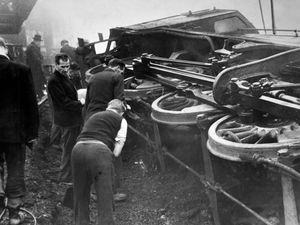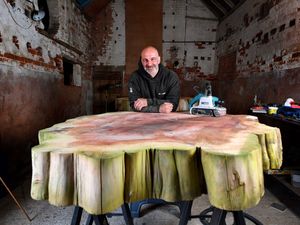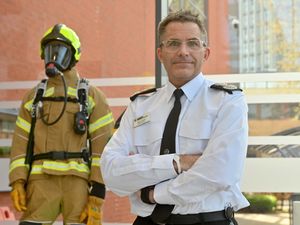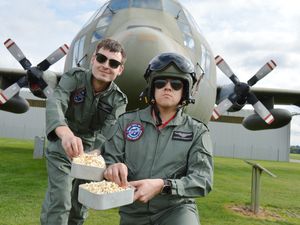Northern Ireland 50 years on: How 1969 troubles brought decades of unrest
Fifty years today British troops moved into Northern Ireland as peacekeepers.

An uneasy peace had broken out in Belfast.
"Beneath the thin veneer of semi-calm lurks hate and fear, which could boil over at any time into another spate of vicious, senseless violence," wrote our reporter Hugh Owens.
Today marks the 50th anniversary of the day British troops were first sent to Northern Ireland, in what was described as a 'limited operation' to restore order following three days of violent riots.
But Operation Banner, as it was known, would run for 38 years, making it one of the longest continual deployments in British history.
The trouble had first flared up in the Bogside area of London on August 11, 1969, during the Apprentice Boys march.
The annual Protestant parade commemorates the defence of the city by 13 boy supporters of William of Orange, who shut the gates when it came under attack from the forces of Catholic King James II in 1688.
Towards the end of the march, it passed the city walls near the Catholic Bogside area, and police came under attack from both Loyalist supporters on the one side, and nationalists in Bogside.
Initially, some loyalists started throwing pennies from the top of the walls at Catholics in the Bogside below, who responded by firing marbles with slingshots.
As the parade passed the perimeter of the Bogside, Catholics started throwing stones and nails.
As the violence escalated, Irish nationalists started throwing petrol bombs from a nearby block of flats, preventing police from entering Bogside to take control.
A full-scale riot quickly developed, with bombs and missiles exchanged by both sides.
As the fighting intensified, rioting also spread to Belfast and other towns in Northern Ireland, and by August 14 seven people had been killed in the Ulster capital, and hundreds more injured.
The sheer scale of the unrest meant the same police officers had been forced to remain on duty for three days and two nights without a break, and tear-gas was deployed for the first time in the Royal Ulster Constabulary's history.
Prime Minister Harold Wilson and Home Secretary Jim Callaghan cut short their holidays for a hastily arranged meeting at RAF St Hawgan in Cornwall.
Prime Minister of the Irish Republic Jack Lynch caused further anger when he suggested United Nations peacekeeping forces should be sent to Northern Ireland.
Major James Chichester-Clark, prime minister of the devolved government in Northern Ireland accused Lynch of 'outrageous interference', and responded by telephoning Callaghan – who was still on a plane heading for the summit in Cornwall – asking for military assistance.
The first 300 troops, from the 1st Battalion, Prince of Wales's Own Regiment of Yorkshire, were deployed to the centre of Londonderry, taking over from the exhausted police officers.
The following day, 600 more soldiers – including a large contingent from the West Midlands – were sent to Belfast.
Initially, the troops were welcomed by both sides, who were eager for an end to the fighting.
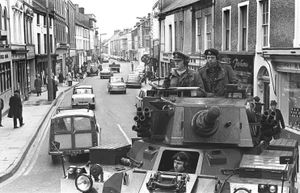
Commander of the 3rd Battalion Light Infantry, Lt Col John Ballenden from Shrewsbury, joked that there was no real need to provide his troops with food as they were being fed so generously by the locals.
Private Ian Slaven, 20, of Wrockwardine Wood, Telford, said: "No-one has taken a pot-shot at us, or anything like that. The reception has been very good."
Corporal Ronald Gittings, 22, from Madeley, added: "The locals are really pleased to see us. They keep coming out every 10 or 15 minutes with sandwiches and cups of tea."
However, one thing this newspaper did observe was that none of the men had any idea of when they would be returning home.
General Sir Ian Freeland, the officer commanding Northern Ireland, told a press conference on August 18 that the 'honeymoon period' for the use of troops was at its peak.
He warned: "If something constructive does not come out of the meeting at Westminster tomorrow, the honeymoon period could finish possibly in a matter of hours."
The honeymoon was indeed shortlived. The following day the troops opened fire on a car which refused to stop for police, racing at 80mph through police checkpoints.
Nobody was injured, and the car's occupants were detained, but it marked the beginning of renewed tensions. The same day, a petrol bomb was thrown through the window of a community centre in the Cregagh area of Belfast.
An offer from the Army to guarantee Catholics living in Bogside their safety in exchange for removing their barricades was rejected as 'unworkable' by Paddy Doherty, of the Derry Citizens Defence Association.
On August 27, Mr Callaghan visited Belfast, and told the people of Northern Ireland that only they could bring peace to the province.
"Only you can decide whether you are are wiling to live in peace with one another, in freedom and equality, and without discrimination," he said.
"We really cannot be dragged back by what took place 50 years ago, even less by what happened 300 years ago."
The Home Secretary said the many letters he received showed an overwhelming desire among the people of Northern Ireland to live together in peace.
That may well have been true, but it was a hope that proved to be in vain.
The bloodshed in Northern Ireland – and in Great Britain – would continue for the best part of three decades.
And the 'limited operation' to halt rioting in Northern Ireland would see troops patrolling the province until 2007.
'We were in at the deep end - it was very scary'
George Green was 23 years old when he was thrust into the maelstrom of violence that had engulfed the streets of Londonderry.
He was one of the first British soldiers to land in Northern Ireland at the start of The Troubles in August 1969, serving as part of a ‘spearhead’ battalion with a remit to quell the violence and restore order.
Having joined the Grenadier Guards in 1963, Mr Green, from Kidderminster, was based in Chelsea Barracks ready to get sent anywhere in the world at short notice.
He had completed a 72-hour guard duty at Buckingham Palace after returning from a stint in Germany, and was expecting to be dispatched to the Far East where trouble was brewing.
But on the evening of August 13 he was in his quarters when a knock on the door brought news of a different deployment.
The following morning Mr Green and the rest of his battalion were sent to Liverpool where they boarded the Sir Tristram ferry and headed over to Belfast.
“They took us to Londonderry and we were the first troops there, just 58 of us in all,” he recalls. “None of us had a clue what to expect.
What greeted them was an area in the throes of a three day riot that would become known as the Battle of the Bogside.
Their only instructions came in the form of a yellow card containing 10 questions that were supposed to help the soldiers work out how best to deal with challenging situations.
“We were in at the deep end,” Mr Green said. “It was very, very scary because we didn’t know who was who out there and what people’s reaction to us would be.
We had to make a decision in a split second, which was very hard. At times you didn’t know who was friend or foe.” Mr Green’s battalion was initially stationed in the old Londonderry prison before they were moved to the Magilligan compound elsewhere in the county.
He served as a driver with the so-called ‘snatch squad’, who would attempt to grab and detain riot ringleaders in the middle of the trouble.
“I made a lot of friends with the people over there on the streets, particularly with the children and their mothers, who used to give us a cup of tea and biscuits,” he said.
“But you would be standing there having a nice chat and the next thing rocks and boulders would be flying over at you.
“A lot of the people you spoke to didn’t really understand what the politicians were trying to do, but the trouble just got worse and worse.”
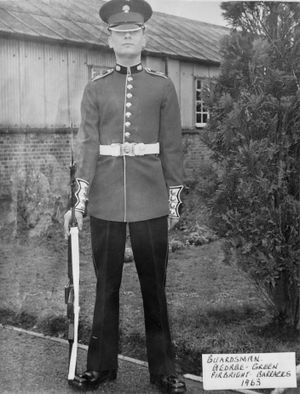
Mr Green and his battalion served in Northern Ireland for just under a year before returning to England.
“We got back and I expected it all to settle down, but it all blew up again in 1970,” he says. “By that stage I think it was clear that what most people thought would be a flare up was actually something far more serious.”
He was preparing for a second tour there but was sent to Honduras instead where he became a jungle warfare instructor.
After finishing in the Army as a drill and weapons instructor at the Army Training Centre at Pirbright, Mr Green returned home to Kidderminster where he joined up with the Worcestershire and Sherwood Foresters Regiment, which later became the Mercians.
The 75-year-old father-of-three received the General Service Medal with the Northern Ireland clasp in recognition of his service.
Limited operation that would last for decades
It was the beginning of the troubles, a ‘small’ operation aimed at restoring order that ended up running for nearly four decades.
When British troops were dispatched to Northern Ireland on August 14, 1969, few would have predicted the violence and bloodshed that would follow as a country divided along sectarian lines.
They were initially deployed as part of Operation Banner, with a remit to restore order after three days of trouble that started during the protestant Apprentice Boys march on August 12.
Nationalists had thrown stones and bottles at the loyalist parade as it passed close to a Catholic area, and protestants responded in kind, leading to a pitched battle between Royal Ulster Constabulary officers and nationalist rioters.
The Battle of the Bogside, as it became known, was the culmination of tensions that had been rising over the previous year, amid a series of civil rights marches and increasingly violent campaigns of civil disobedience.
The violence soon spread beyond the boundaries of Ireland – to devastating effect – as armed paramilitary organisations were formed and blood began to flow.

The violence started to hit mainland England in the early 1970s.
In February 1972 seven people were killed by an IRA bomb at Aldershot Barracks, and on March 8, 1973 one civilian was killed and 200 people injured when the Old Bailey courthouse was bombed.
The number of terrorist attacks ramped up the following year, which saw bombs detonated in Bristol and in London’s Oxford Street, while several pubs were targeted, including the Kings Arms in Woolwich and the Horse & Groom and Seven Stars in Guildford.
Then came the devastation of the Birmingham pub bombings on November 21. B
ombs exploded within 10 minutes of each other in two city centre pubs, the Mulberry Bush and the Tavern in the Town, leaving 21 people dead and another 182 injured.
The IRA has never officially admitted responsibility for the attacks, although a former senior officer confessed to the group’s involvement in 2014.
It was the deadliest act of terrorism to take place in England between the Second World War and the London bombings in 2005.
In 1989 the IRA attacked the Clive Barracks in Tern Hill, Shropshire.
Around 50 soldiers from the 2nd Battalion the Parachute Regiment were at the site when two men were spotted acting suspiciously in the early hours of the morning of February 20. The barracks was evacuated shortly before two bombs went off.
Lance Corporal Norris saw and challenged the terrorists, who dumped a sports bag containing a third bomb and fled the scene.
The Tern Hill attack formed part of a mainland bombing campaign that saw the IRA hit the Inglis Barracks in north London in August 1988, killing one in what marked the first attack in England since the infamous Brighton hotel bombing in October 1984.
Terrorists also struck in Deal in September 1989, killing 11 Royal Marine bandsmen.
The Troubles were brought to an end when the Good Friday agreement was signed in 1998, although pockets of violence occurred after that date.
Operation Banner was officially closed in 2007 when the last British troops left the Bessbrook Barracks in County Armagh.
It is believed that around 3,500 people were killed in the conflict, including an estimated 1,800 civilians and 1,200 British soldiers.


